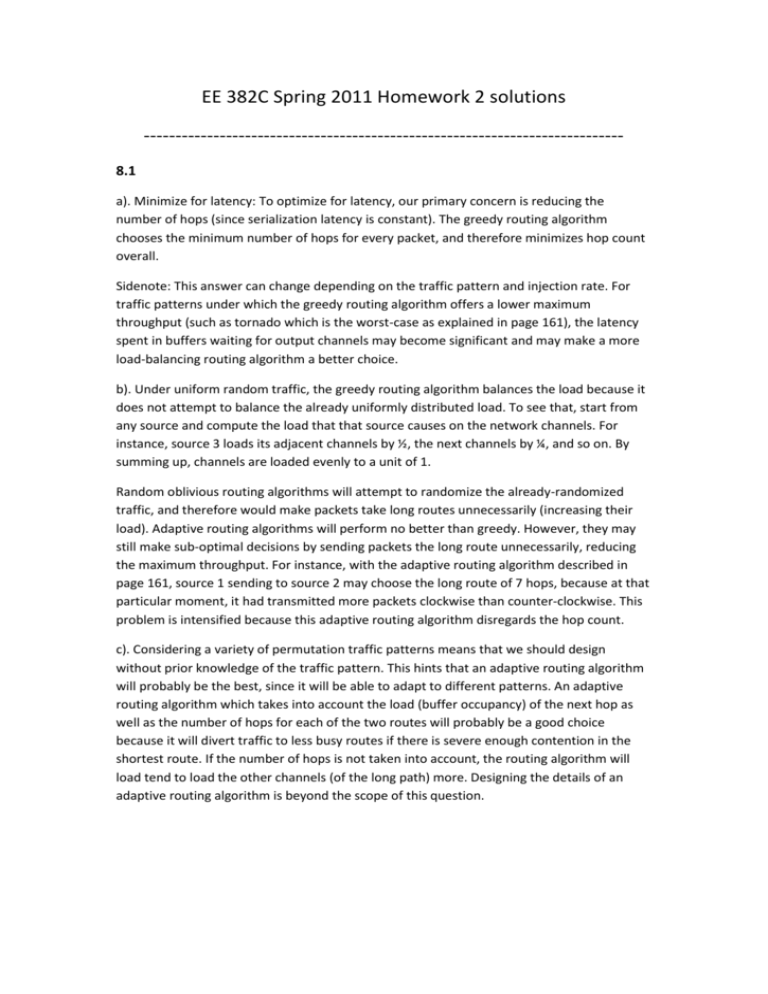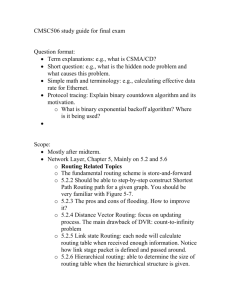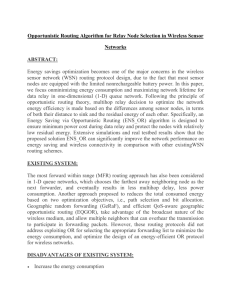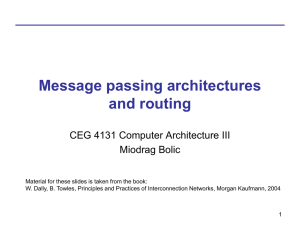EE 382C Spring 2011 Homework 2 solutions
advertisement

EE 382C Spring 2011 Homework 2 solutions ---------------------------------------------------------------------------8.1 a). Minimize for latency: To optimize for latency, our primary concern is reducing the number of hops (since serialization latency is constant). The greedy routing algorithm chooses the minimum number of hops for every packet, and therefore minimizes hop count overall. Sidenote: This answer can change depending on the traffic pattern and injection rate. For traffic patterns under which the greedy routing algorithm offers a lower maximum throughput (such as tornado which is the worst-case as explained in page 161), the latency spent in buffers waiting for output channels may become significant and may make a more load-balancing routing algorithm a better choice. b). Under uniform random traffic, the greedy routing algorithm balances the load because it does not attempt to balance the already uniformly distributed load. To see that, start from any source and compute the load that that source causes on the network channels. For instance, source 3 loads its adjacent channels by ½, the next channels by ¼, and so on. By summing up, channels are loaded evenly to a unit of 1. Random oblivious routing algorithms will attempt to randomize the already-randomized traffic, and therefore would make packets take long routes unnecessarily (increasing their load). Adaptive routing algorithms will perform no better than greedy. However, they may still make sub-optimal decisions by sending packets the long route unnecessarily, reducing the maximum throughput. For instance, with the adaptive routing algorithm described in page 161, source 1 sending to source 2 may choose the long route of 7 hops, because at that particular moment, it had transmitted more packets clockwise than counter-clockwise. This problem is intensified because this adaptive routing algorithm disregards the hop count. c). Considering a variety of permutation traffic patterns means that we should design without prior knowledge of the traffic pattern. This hints that an adaptive routing algorithm will probably be the best, since it will be able to adapt to different patterns. An adaptive routing algorithm which takes into account the load (buffer occupancy) of the next hop as well as the number of hops for each of the two routes will probably be a good choice because it will divert traffic to less busy routes if there is severe enough contention in the shortest route. If the number of hops is not taken into account, the routing algorithm will load tend to load the other channels (of the long path) more. Designing the details of an adaptive routing algorithm is beyond the scope of this question. 8.9 Since the torus is symmetric, it is sufficient to look at a single dimension, i.e., a ring with k nodes. We first determine the channel load that each node contributes. Due to symmetry, the load on all channels in a given direction is identical, and we can compute it simply by adding up the total load a single node contributes on all channels in that direction. For uniform random traffic, every node sends 1/k units of load to each node in the network, including itself. Sending to itself does not contribute any channel load. Sending to the (k/2)-1 nodes that are closer in positive direction contributes 1, 2, …, (k/2)-1 units of traffic in that direction, respectively, each with probability 1/k. Likewise, sending to the (k/2)-1 nodes which are closer in negative direction contributes 1, 2, …, (k/2)-1 units in that direction with probability 1/k each. Finally, sending to the node at the opposite end of the ring contributes k/2 units of load in positive direction with probability 1/k, whereas it would contribute k/2 units of load in either direction with probability 1/(2k) in the load-balanced case. Summing up, we can compute the load on each channel in positive and negative direction for uniform random traffic as UR, pos k 2 0 1 1 1 k k k 1 k 2 i 1 and k k i1 k 2 2 2 8 4 8 k UR,neg 1 0 1 2 1 1 k k k 1 k 2 i 1 , k k i1 k 2 2 2 8 4 8 respectively. For the load-balanced case, on the other hand, the channel load in either direction is k 1 0 1 2 1 k k 1 1 k bal i . k k i1 2k 2 8 4 4 8 Since throughput is inversely proportional to channel load, the throughput for the uniform random case relative to capacity (i.e., relative to the throughput for the load-balanced case) is given by UR bal UR,pos k ideal . k2 In the worst case, each node sends to the node at the opposite end of the dimension, and thus contributes k/2 units of load in positive direction with probability 1. Thus, the channel loads for this case are W C,pos 1 ideal k k and W C,neg 0 . 2 2 Comparing again to the channel load for uniform random traffic with load-balanced routing, throughput isnow W C bal W C, pos ideal 1 ideal . 4 To improve load balance for the half-way case while keeping the routing decision deterministic, one simple approach is to have nodes determine which direction to send such traffic in based on their own location; i.e., all even nodes send half-way traffic in positive direction, while all odd nodes send it in negative direction. For uniform random traffic, when averaging over all nodes, this balances the half-way traffic across both directions; as the remaining traffic is balanced to begin with, throughput in this case is the same as that for the randomly balanced approach, and thus equals capacity. For the case where each node sends to the node at the opposite end of the dimension, load is also balanced across both directions. Consequently, channel load is cut in half, and throughput is doubled compared to the case where all half-way traffic is sent in one direction, achieving half of capacity. However, with the load now balanced across both directions, this traffic pattern actually no longer represents the worst case for k>2. Instead, we can restore load imbalance by having each node send its traffic (k/2)-1 hops in positive direction (this is the “Tornado” traffic pattern). This yields channel loads of k 2 k 2 and W C,neg 0 , and thus 2 W C,pos 1 1 W C bal k ideal ideal . W C,pos 4 k 2 9.5 We have 1024 nodes choosing at random an intermediate node from the same pool of 1024 nodes. We can assume that each selection is random and independent. Therefore, the number of source nodes that select a particular node as intermediate can be calculated using the bins and balls model (binomial distribution). The probability (p) that a source node will choose a particular intermediate node is 1/1024. The number of trials (n) is 1024. Therefore, the expected value of this random variable is the expected number of source nodes that choose any particular intermediate node and is E np 1024 1 1024 With a high probability of 1 1 3 ln( 1024) 10.7405 balls. This , all bins have at most 1024 ln(ln( 1024)) is the maximum expected value for how many source nodes choose the same intermediate node. You can read more on binomial distributions and the proof for the maximum expected value at: http://pages.cs.wisc.edu/~shuchi/courses/787-F09/scribe-notes/lec7.pdf Note that generating a comparable result using simulation experiments is also acceptable. 10.4 It is possible for adaptive routing to have zero dropping probability when routing upstream in a Clos network, because it can avoid conflicts. For instance, adaptive routing can make packets use different paths if there are other packets contending for the same path. However, this is not true for oblivious routing. Since oblivious routing does not regard the current network load and what other packets are requesting, it can easily route two packets to the same output at the same time, causing a drop. Oblivious routing may load balance by average, but is prone to transient imbalance. When routing downstream, both routing algorithms will have the same dropping probability because there is only one path to the destination. Therefore, adaptive routing will have a lower dropping probability. Assuming nearest-common-ancestor routing, dropping probability increases as the locality of traffic decreases. That is because less local routes require packets to traverse more channels to reach a switch from which they can route to their destination. Therefore, the probability of contention along the path that results in packets being dropped increases.








